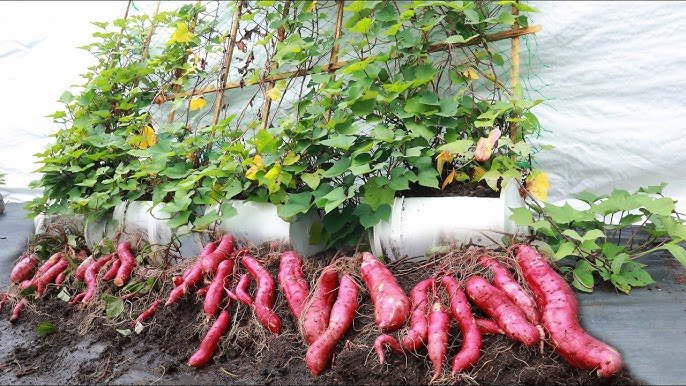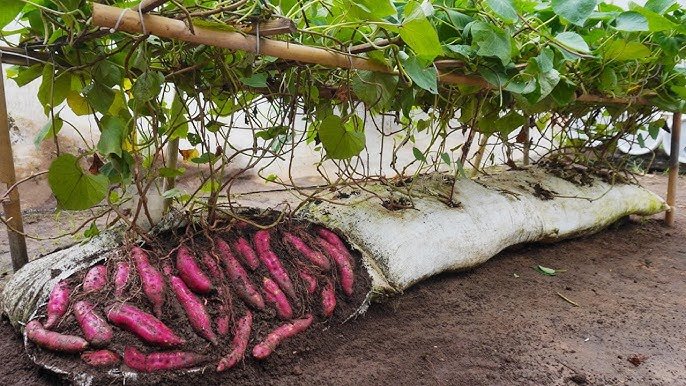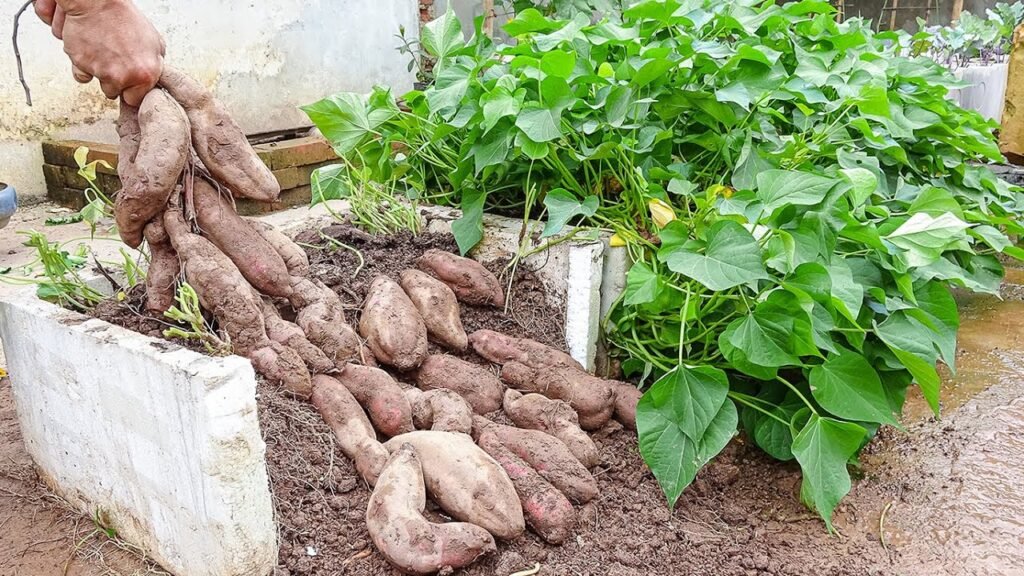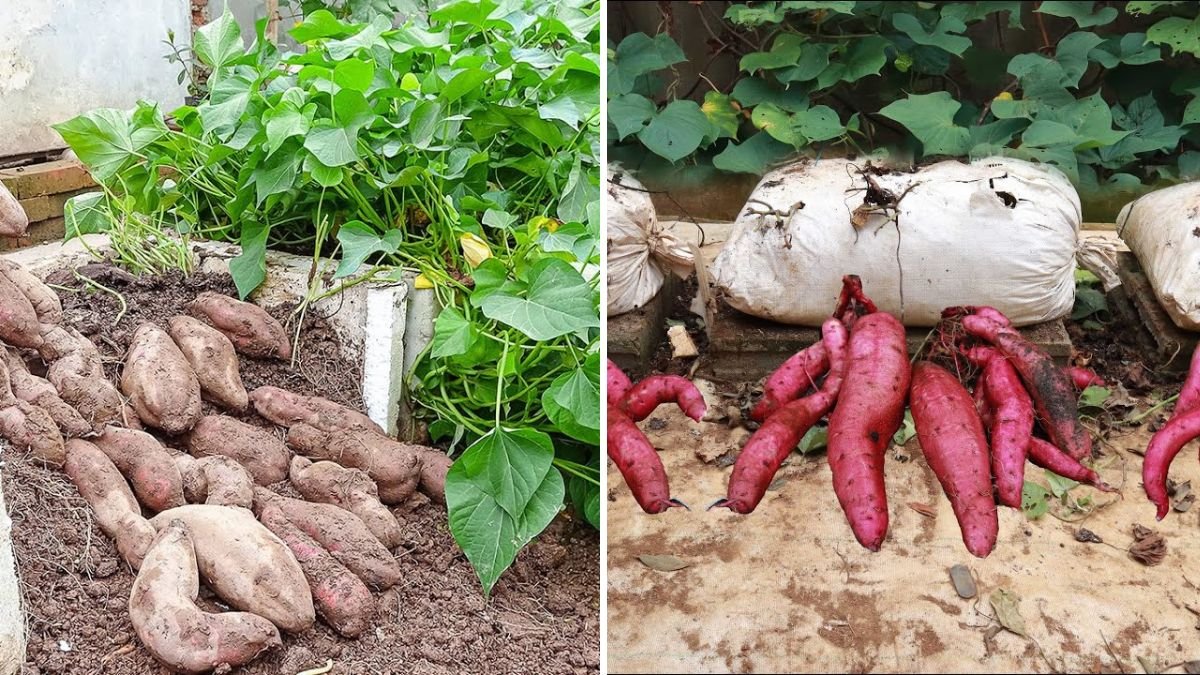Sweet potatoes are not only delicious and nutritious but also surprisingly versatile in the kitchen. Traditionally grown in fields with plenty of soil, growing sweet potatoes at home may seem challenging, especially if you don’t have a backyard or garden. However, an experiment in terrace gardening has shown that sweet potatoes can thrive in containers, raised beds, or pots on a terrace, producing an impressive yield. This method is perfect for urban dwellers who want to grow their own food and enjoy the satisfaction of homegrown produce. In this article, we explore the experiment of growing sweet potatoes on a terrace, share tips for success, and reveal why the results were so surprising.
Why Grow Sweet Potatoes at Home?

Growing sweet potatoes at home offers several benefits:
- Nutritional Value: Sweet potatoes are rich in vitamins A and C, fiber, potassium, and antioxidants.
- Cost-Effective: Growing your own vegetables reduces grocery expenses over time.
- Urban Gardening Friendly: Perfect for terraces, balconies, and small spaces.
- Sustainable Living: Homegrown sweet potatoes reduce food miles and promote organic practices.
- Satisfaction: Watching a plant grow from a vine to a harvestable tuber is immensely rewarding.
The idea of growing sweet potatoes on a terrace transforms urban spaces into productive green areas, offering both aesthetic and practical benefits.
Choosing the Right Variety

Not all sweet potato varieties are suitable for terrace or container gardening. For home-based terrace experiments, select varieties that are compact, fast-growing, and high-yielding:
- Beauregard: Known for its sweet flavor, reddish skin, and high yield.
- Georgia Jet: Early-maturing variety, perfect for small spaces.
- Japanese Sweet Potato (Satsumaimo): Long, sweet, and suitable for container growth.
Choosing the right variety ensures better growth, easier maintenance, and higher chances of success in limited space.
Preparing Containers for Terrace Growth
Terrace gardening requires containers or raised beds that can support the growth of sweet potatoes, which develop tubers underground.
- Container Size:
- Use deep containers or large pots with a minimum depth of 12–15 inches.
- Wide containers allow enough space for tubers to spread and grow.
- Drainage:
- Ensure containers have drainage holes to prevent waterlogging.
- Excess water can cause tuber rot and fungal diseases.
- Soil Mix:
- Sweet potatoes prefer loose, well-draining soil rich in organic matter.
- A mixture of garden soil, compost, and sand or perlite works best.
- Avoid compacted soil, which can restrict tuber development.
- Sunlight:
- Sweet potatoes require full sun for at least 6–8 hours daily.
- Position containers in the sunniest part of the terrace for optimal growth.
Starting the Experiment: Planting Sweet Potatoes

Sweet potatoes are typically grown from slips—small shoots sprouted from mature tubers.
- Preparing Slips:
- Soak healthy sweet potatoes in water for 3–4 weeks to encourage sprouting.
- Once sprouts appear, carefully separate them from the tuber.
- Planting Slips:
- Plant slips in containers or raised beds, burying them about 2–3 inches deep.
- Space slips at least 12 inches apart to allow room for vines and tubers.
- Watering:
- Water immediately after planting and keep the soil consistently moist for the first few weeks.
Starting the experiment with healthy slips is crucial for a successful terrace harvest.
Terrace Care and Maintenance
Growing sweet potatoes on a terrace requires regular attention to ensure healthy vines and abundant tuber formation:
- Watering:
- Sweet potatoes need regular watering, especially during hot weather.
- Avoid overwatering, which can lead to root rot.
- Fertilization:
- Use balanced organic fertilizers or compost to provide nutrients.
- Excess nitrogen should be avoided, as it encourages vine growth at the expense of tubers.
- Pruning and Training:
- Trim vines that spread too widely to control space on the terrace.
- Sweet potato vines can climb walls or trellises, adding greenery to your terrace.
- Pest and Disease Management:
- Common pests include aphids, whiteflies, and sweet potato weevils.
- Use neem oil, insecticidal soap, or natural predators to control infestations.
- Ensure good airflow to prevent fungal diseases.
Regular maintenance ensures strong growth, healthy foliage, and a higher yield of tubers.
Monitoring Growth and Surprising Observations

During the terrace experiment, several surprising observations were made:
- High Yield in Containers: Despite limited soil volume, sweet potatoes produced an impressive number of tubers. Proper soil preparation and container depth were key factors.
- Vine Growth: Vines grew vigorously, covering walls and railings, creating a beautiful green canopy on the terrace.
- Adaptability: Sweet potatoes adapted well to container conditions, proving that traditional ground planting is not always necessary.
- Minimal Pests: Urban terrace conditions and proper care reduced common pest infestations compared to field-grown crops.
These results demonstrate that with the right techniques, terrace-grown sweet potatoes can rival traditional garden yields.
Harvesting Sweet Potatoes

Harvesting sweet potatoes on a terrace is an exciting part of the experiment.
- Timing:
- Sweet potatoes are typically ready for harvest 90–120 days after planting, depending on the variety.
- Leaves may start yellowing, signaling that tubers are mature.
- Method:
- Carefully remove soil from the container to avoid damaging tubers.
- Use hands or a small spade to lift tubers gently.
- Storage:
- Cure sweet potatoes by leaving them in a warm, dry area for 5–7 days.
- Store in a cool, dry, and dark place to maintain quality.
The satisfaction of harvesting homegrown sweet potatoes from a terrace garden is unmatched, especially when you witness the surprising abundance from a limited space.
Advantages of Terrace-Grown Sweet Potatoes
Terrace gardening offers multiple benefits:
- Space Efficiency: Ideal for urban homes with no backyard.
- Aesthetic Appeal: Sweet potato vines provide greenery and cover for terrace walls.
- Organic Produce: Homegrown tubers are free from harmful chemicals.
- Environmental Benefits: Reduces food miles and promotes sustainable urban living.
- Surprising Yields: Proper care can result in more than expected, making terrace gardening highly productive.
This experiment proves that even in small spaces, you can grow nutritious and tasty crops successfully.
Tips for Success in Terrace Sweet Potato Gardening
- Choose high-yield, compact varieties for container growth.
- Use deep, wide containers with rich, well-draining soil.
- Position containers for maximum sunlight exposure.
- Maintain consistent watering and regular fertilization.
- Train vines on trellises or walls to save space.
- Monitor for pests and diseases and take prompt action.
- Harvest carefully to avoid damaging tubers.
Following these tips ensures a healthy, productive terrace sweet potato garden.
Conclusion
The experiment of growing sweet potatoes on a terrace has shown that with creativity, proper techniques, and dedication, even urban dwellers can enjoy the benefits of homegrown vegetables. From selecting the right varieties and containers to nurturing vines and harvesting bountiful tubers, terrace gardening proves that limited space does not limit possibilities.
Surprisingly, this urban gardening experiment yielded more than expected, demonstrating the adaptability and resilience of sweet potatoes. For anyone looking to grow nutritious, sustainable, and delicious food at home, terrace gardening is a practical and rewarding solution.
Whether you live in an apartment, have a rooftop, or simply want to explore container gardening, sweet potatoes are a perfect choice. The combination of aesthetic greenery, nutritional benefits, and the joy of harvesting your own food makes terrace-grown sweet potatoes a truly rewarding project.
